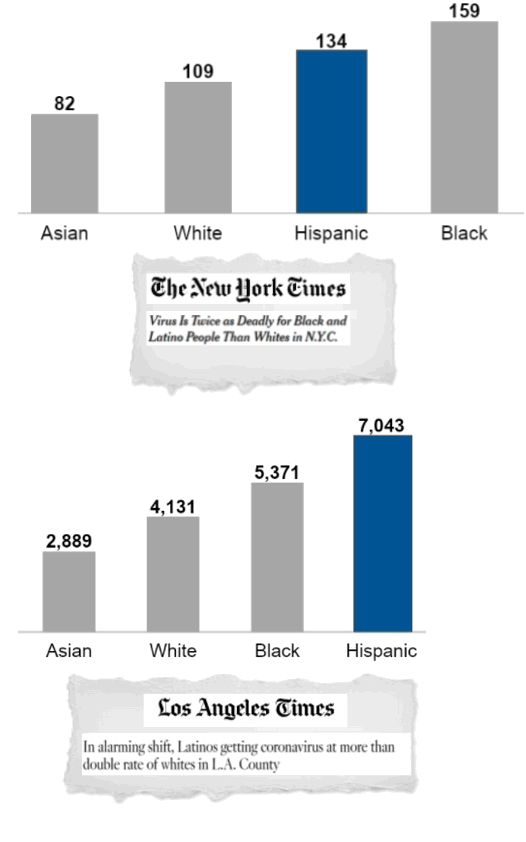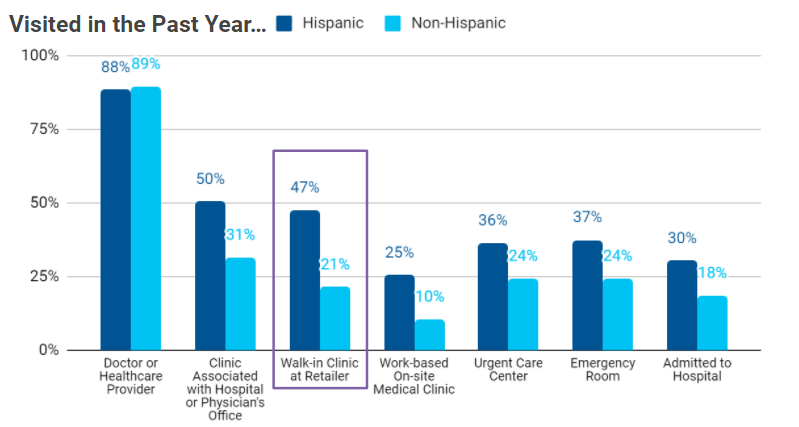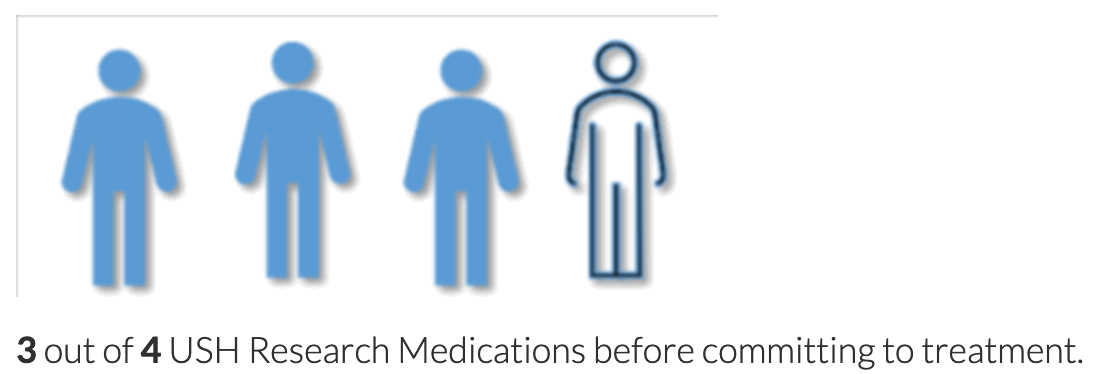Six Hispanic Healthcare Insights for Successful In-Culture Marketing
February 1, 2022

As Latinos welcomed the New Year, the traditional “Salud!” was the quintessential closing to every family’s wishful holiday toast. And while the pandemic has certainly made public health concerns top-of-mind for most, it’s no secret that health and wellness have always been high priorities for U.S. Hispanics, who rank the importance of their health higher than non-Hispanics.
When it comes to healthcare, trust, cultural relevance and accessibility are fundamental barriers that must be overcome to engage and better serve diverse communities. Understanding Latinos’ nuanced healthcare needs and challenges is therefore essential when planning and executing successful in-culture marketing strategies. If you’re in the business of health, here are 6 healthcare insights to consider when marketing to Hispanics.
1. A bigger familia means growing challenges and opportunities
Latinos constitute 19% of the U.S. population and represent 51% of the nation’s population growth. These telling numbers have brought a general rise in healthcare demand and Hispanics’ focus on preventative care is driving significant industry growth. However, as this community keeps growing, so too do their healthcare demands and their barriers to access.
For instance, while Hispanics make up 19% of the U.S. population, there are more than 1 million pregnant Hispanic women every year, making up 25% of all U.S. births. Similarly, 1 in 4 children under the age of 2 are Hispanic. Hispanics are also the fastest growing 65+ group in the nation, with a total of 5 million over the age of 65 and 600 thousand turning 65 each year. As this community continues to grow, so will opportunities for healthcare retailers and providers to address their needs.
2. Hispanics’ healthcare needs are wide ranging
A strategic, nuanced approach is key when addressing a complex and diverse market. Identifying the different healthcare needs of the Hispanic population will illuminate the best ways for brands to engage with them.
For example, certain health conditions and illnesses are more prevalent among Hispanics. There are 26 million obese U.S. Hispanics, and this group is more likely to be obese compared to non-Hispanics (47% vs. 38%). Hispanics also index higher for chronic illness: They are twice as likely to develop Diabetes (22.6% vs. 11.3%), more likely to suffer from Hepatitis C (2.6% vs. 1.3%) and three times more likely to contract HIV than non-Hispanics.
Recent data also suggest the Hispanic community has been more heavily impacted by COVID-19. Hispanics are infected by COVID-19 at greater rates than any other group, while Hispanics and Blacks are dying from COVID-19 at higher rates.

Accessibility is also a challenge for this community. As the largest segment of uninsured Americans, it’s no wonder 43% of Hispanics feel overwhelmed when taking care of their health, while 45% (versus 26% of non-Hispanics) do not feel that they have excellent or great health. With so much room for improvement, the field of Hispanic Healthcare is clearly rife with opportunities.
3. Hispanics face unique barriers to healthcare
From finances to culture, U.S. Hispanics face a myriad of obstacles when accessing timely, quality health products and services.
Although access to healthcare services continues to be a challenge (19% of Hispanics are uninsured, compared to 6.3% Non-Hispanic white), low health literacy among Hispanics also fosters poor communication, causing delays getting care, not receiving the needed care and the additional stress of not having adequate care.
While the pandemic has driven healthcare to become more transactional, with drive-through pharmacies and virtual appointments, Hispanics continue to place a high value on interpersonal relationships. For a wide range of healthcare needs, Hispanics prefer Walk-In clinics as their first step for routine support. Doctors tend to be seen as authoritative, intimidating figures, especially when facing language barriers, which is why retail-based clinics in a familiar and accessible location are more approachable and less intimidating.

The role of pharmacists is also fundamental for Hispanics: 62% tend to rely on pharmacists for information on their Rx medication, while 48% regularly ask their pharmacist for OTC product advice. A significant 23% consider recommendations from their pharmacist as an essential feature for OTC purchases, and 21% bought an OTC brand based on their pharmacist’s recommendation. This is likely due to the prominent role pharmacists play in Latin America, in addition to the fact that pharmacists are approachable and trusted local reference points for a given community.
4. Language and culture are key to understanding the healthcare experience
Cultural experiences and preferences act as a filter for consumer behavior, and the healthcare industry is no exception. For example, 60% of U.S. Hispanics have experienced difficulties communicating with a healthcare provider because of a language or cultural barrier. Conversely, 62% prefer resources that allow them to receive information in Spanish if they want, and 57% find it easier to understand ads for prescription medication when they are in Spanish.
However, language proficiency alone does not always determine health literacy. Despite a large percentage of the population being bilingual, often Hispanic patients need their healthcare providers to provide easy-to-follow communication pieces that can guide them through their journey.
They are also more likely than Non-Hispanics to gather free information about their health, such as calling toll-free health numbers, getting information on a prescription or ailment on social media, or watching TV health ads. They believe this information can not only save them money by finding alternative solutions to their ailments, but it also empowers them to better understand their healthcare provider when they talk to them about a condition or a treatment.
5. Hispanics are health info super-searchers
In order to better control and manage their health, Hispanics turn to search for accessible information, with 62% using search as their go-to source of information, including platforms such as YouTube, as well as clickable online ads and TV ads.

Additionally, social platforms such as Facebook play a significant role in exchanging information and building communities around specific health topics and conditions. Social media also offers new ways to connect with healthcare experts and get actionable advice in a more relatable and interpersonal way.
6. When it comes to health, trust is key
Since the onset of the COVID-19 pandemic, conflicting messages regarding symptoms and healthcare have created confusion. However, while many may question the accuracy of news outlets, Hispanics generally remain loyal to the brands and products they trust.
This represents an opportunity to leverage and continue building brand trust. However, Hispanics need health solutions and communications to be tailored and culturally relevant, in order for them to feel more comfortable with treatment and prescription medication, and keep them from defaulting to home remedies.
It is also important to consider that Hispanics combine traditional beliefs with modern medicine as a form of “Medical Pluralism”. They use the internet and social media as a vehicle to close the healthcare information gap and feel more comfortable and better prepared before visiting a provider. They gravitate towards more personal Healthcare relationships as this reduces intimidation and increases their level of comfort to ask questions.
From insights to action
Multicultural marketing continues to grow as more and more brands recognize the potential of catering to a more diverse consumer base, and healthcare is no exception. These six insights allow healthcare brands to more easily identify challenges, areas of opportunity and ways to amplify current marketing programs focused on U.S. Hispanics. Partnering with firms specialized in engaging diverse consumers will be instrumental in helping brands navigate the nuances of culture and build effective and profitable marketing strategies.
Sources:
- Nielsen/Univision Hispanic Patient Journey, 2016
- Nielsen Target Track FY 2020
- CDC National Vital Statistics Reports “Births: Final Data for 2017”
- US Census National Projections, Released Dec 2017
- Journal of American Medical Association “Prevalence of and Trends in Diabetes Among Adults in the United States”, Sept 2015
- HCV Advocate “Hepatitis C and US Hispanics”, 2014
- DC Fact Sheet “HIV among Latinos”, Feb 2019
- CDC National Health and Nutrition Examination Survey, 2015-2016
- Boston University The COVID Tracking Project, Nationwide through 2.10.21. **51 of 56 states and territories report race/ethnicity information for cases. Race categories may overlap with Hispanic/Latino ethnicity. Some rates are underestimated due to lack of reporting of race and ethnicity categories for COVID-19 cases and deaths
- Pew Research Fact Tank 2017 How the US Hispanic Population is Changing, IHS Global Insights 2015, AP NORC, 2018, Communication And
- Long-Term Care: Technology Use And Cultural Barriers Among Hispanics
- Latinos Have Health Care Communication Woes. Emily Swanson and Russell Contreras, Associated Press, July 27, 2018
- 2021 MRI-Simmons Spring Doublebase USA. *Index vs Total Population
- ThinkNow, 2022.































